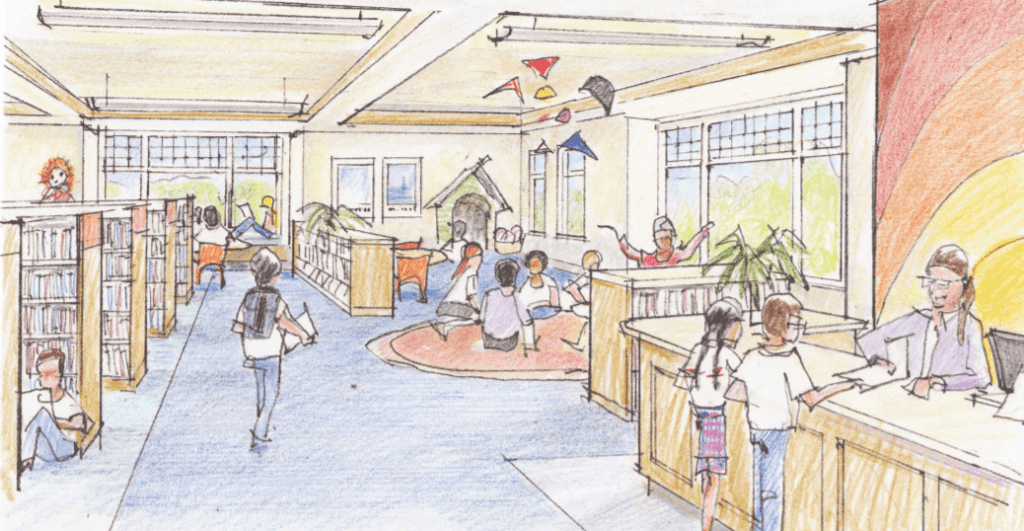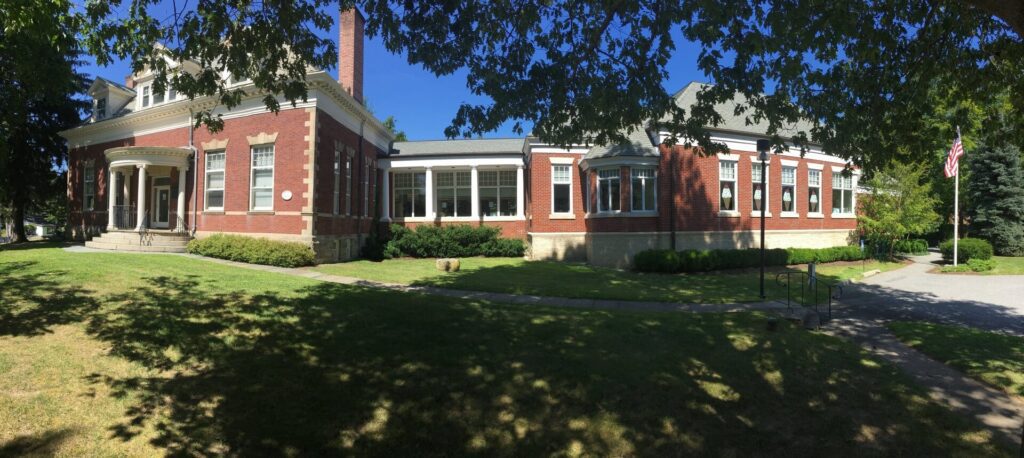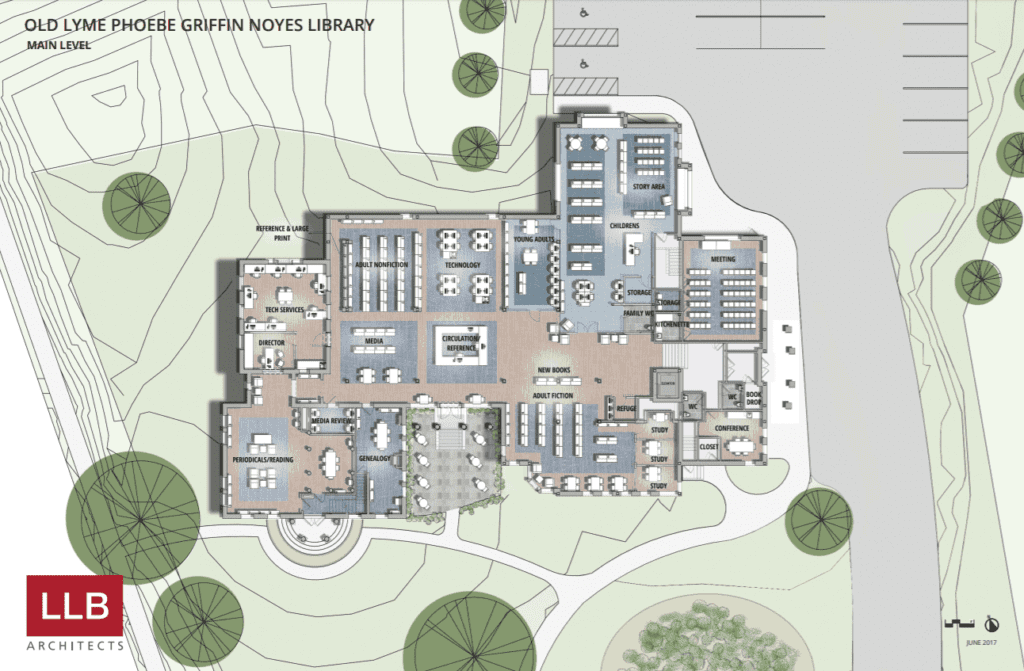OLD LYME — The interior walls may change, but the footprint of the Old Lyme Phoebe Griffin Noyes Library will remain the same after its $3.05 million phased renovation scheduled to begin in September or October 2019 and to finish in Spring 2020.
Along with hiring Lerner, Ladds and Bartels Architects of Providence, Rhode Island, to do a feasibility study in early 2017, the library performed a survey to determine how residents used the library, to evaluate the current library, and to suggest what the library could do better, said Huffman.
With nearly 19,000 square feet of usable space, the current building is a combination of an original 1898 structure, a 1925 addition, and a much larger 1995 addition when the library’s mechanical systems, furnishings and finishes were last updated.
“We knew we were nearing the 25-year mark and we needed to do some significant maintenance to the building itself,” said Katie Huffman, the library’s director since September 2016, who spoke in her office on April 19. “The building hadn’t been painted, carpet hadn’t been replaced, mechanical systems needed updating,” she said. The library’s rooftop HVAC units, two boiler pumps and the building’s lighting fixtures were also approaching the end of their life expectancy.
More than Books
The survey revealed that residents still rely on the library for books, but also wanted additional technology services and more meeting space. The library’s large meeting space was used over 200 times last year by non-library groups and local organizations, including the Boy Scouts and the Girl Scouts and by town committees that increasingly need space to conduct public meetings, said Huffman.
Even with the founding of Google in 1998, the library has seen a 70% increase in reference questions since 1996. The library also increased its offerings and programs, such as storytimes, educational lectures and arts and entertainment by 90% since 1996, and attendance has increased by 140%, according to the library’s Renewal Campaign brochure.
More people are also telecommuting or working remotely and are looking for an open, public, safe, professional environment to meet clients without the interruptions and noise of restaurants or coffee shops, Huffman explained.
“We have also seen an increase in the number of people who are looking for a safe, public space to conduct a personal meeting, such as a college interview,” she said. “We’re in an age where people feel much more comfortable having that type of interaction in public as opposed to in a private home.”

To meet these needs, the board has hired TSKP Studio of Hartford to design a new space, which will include updates to the large meeting room and the addition of a small conference room for 6-8 people. The plan also includes two small study or tutoring rooms, a dedicated storytime and craft space within the Children’s Room on the lower level, a new Young Adult room, a new patio in the courtyard overlooking Lyme St., and more open seating space on the main level.
Funding the Renovation
Funding for the $3.05 million project will come from several sources. At a July 23, 2018 town meeting, Old Lyme residents approved $1.75 million in funding for the library renovation, voting 104 to 30 in favor of the project.
To fund the $1.75 allocation, the Board of Finance approved the use of $500,000 from surplus in the 2019-2020 budget. The town will send out bid requests for a bank loan this summer to cover the remaining $1.25 million, said Nicole Stajduhar, finance director for the town, in an April 26 email. A loan will allow the town to avoid the significant cost and staff time required to go out for bonding, she explained. “We have several banks already expressing interest in the loan and feel confident we can obtain a competitive offer.”
The library also secured a $1 million construction grant from Connecticut State Library in 2017 that was approved by the State Bonding Commission in December 2018. The project is one of 18 “in construction” library projects receiving Connecticut State Library grants totalling $12.5 million as of April 2019.
A $1.25 Million Fundraising Goal
The project’s remaining $300,000 in construction costs are budgeted to come from a larger library fundraising effort for $1.25 million to grow the library’s $4 million endowment and to reimburse it for $58,000 used to fund a feasibility study.
The library’s annual budget of $760,000 is provided by the town, the library endowment and by annual fundraising. The town provided $335,000 to the library in 2018-19, and will provide $345,000 in the 2019-20. The endowment provides about $240,000. Fundraising provides the remaining $165,000-$175,000.

In a phone conversation on April 19, library board president Kirsten Sicuranza explained that the board was endeavoring to put money back into the endowment to support the library’s expanded operation. “We don’t want to expand services and not be able to support them,” she said. “We’re trying to be more responsive to the way libraries are today and the board definitely wanted to know if what we were endeavoring was possible within the funding we had.”
“Libraries have been doing things like book clubs and community involvement exercises for decades and decades, it’s always been a piece of what we do, but as we move forward and look to the future, we see [this activity] as being more fundamental,” she said. “It used to be an “add-on” to our mainstays, but now it’s becoming core and vital to the library’s mission.”
Huffman said the renovations will reflect and reinterpret traditional library services, which she defined as connecting people with information. “We like to think of that very broadly. Information can be in books, it can be on the internet, but it can also be from people’s colleagues and associates and neighbors, especially in a world where people tend to be more isolated or alone,” she said. “Connecting people to one another is a real need that we are more than able and willing to help facilitate.”


